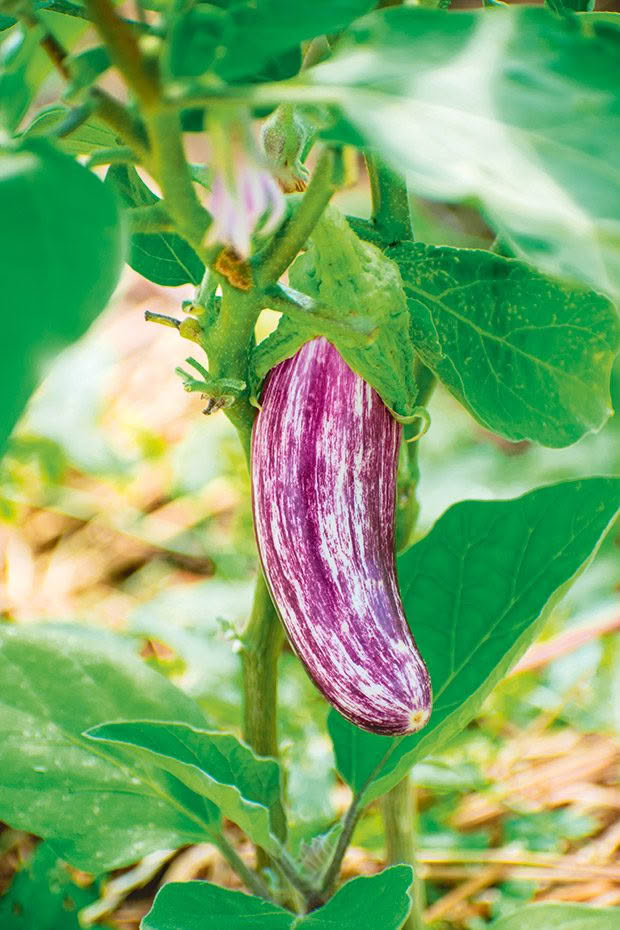How to grow great eggplants in New Zealand

Some people have dismal luck with eggplants, but warmth is the essence of a thriving crop.
Words: Extract from Nadia: A Seasonal Journal
Eggplants are an ancient plant – a gift from the East we can now cultivate at home. Better known as aubergine or brinjal in parts of the world, biologically they belong to the same family as potatoes and tomatoes. Some people have dismal luck with eggplants, but warmth is the essence of a thriving crop – eggplants aren’t easy to grow in Central Otago. This warm-weather vegetable won’t produce fruit until daytime temperatures consistently exceed 21°C and nights reach 13°C.
BRRR, WARM ME UP
Eggplants grow quickly from seed. Sow in trays or pots for transplanting into the garden when the seedlings reach about 10cm high. A soil thermometer is helpful when planting them out because they like a minimum soil temperature of 18°C. If it’s too cold in your area, grow in pots and keep in a sheltered spot.
FEED THEM LEFTOVERS
Before planting in the garden, dig in plenty of compost, a handful of sheep pellets – even fish scraps from the previous night’s dinner if you have them. Regularly apply small amounts of liquid fertiliser such as comfrey tea throughout the growing season. Apart from their initial feed, avoid fertilisers high in nitrogen or you’ll get an overabundance of leaves and few or small fruit. Water well when it’s dry.
I CAN SEE A RAINBOW
We’re all familiar with the traditional large, purple shiny eggplants (‘Black King’ and ‘Early Prolific’ are heavy croppers). But there are numerous other varieties – from the small golfball-sized round ones to the long skinny ones. Besides purple, they grow in many colours, including white, green, yellow and speckled.
‘Florence Round Purple’ is round and purple and occasionally sports creamy white stripes. (The Kōanga Institute, dedicated to preserving Aotearoa’s heritage food plants, calls it one of the easiest eggplants to grow.) ‘Long Purple’, also known as ‘Early Long’ and ‘Italian Heirloom’, has dark-purple cylindrical fruit that grows 20cm long. ‘Ping Tung Long’ has even skinnier fruit, about 5cm wide and up to 30cm long, and ‘Rabi Long Green’ is similar, except it’s green. These finger types are delicious sliced in half lengthwise and thrown on the barbie or under the grill. Or you can cut small rounds and toss them into a stir-fry.
Some of the round types include ‘Thai Green Egg’ (with small green and white egg-shaped fruit, 4-5cm in diameter), ‘Thai Purple’ (a bright purple ball that’s 5-7cm in diameter when mature) and ‘Thai Oval’ (similar size but oval rather than round). There’s even an all-white variety called ‘White Star’, which has fat, white, tear-shaped fruit. Pick the fruit while it’s still tiny or leave it to mature to about 15cm long and 5cm wide.
QUICK TIPS
Grow from seed or seedlings
Sow indoors in trays or pots from late winter through spring. Keep indoors until planting outside from mid-spring in warm areas and late spring in cooler regions.
Space 50-60cm apart
Crops after 100-120 days from sowing, depending on the variety
Crop rotation: follow alliums (onions of all types)
Plant family: Solanaceae
 This article first appeared in Nadia: A Seasonal Journal Magazine.
This article first appeared in Nadia: A Seasonal Journal Magazine.

